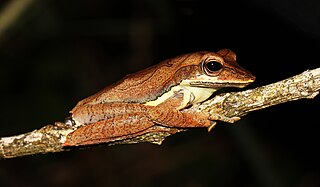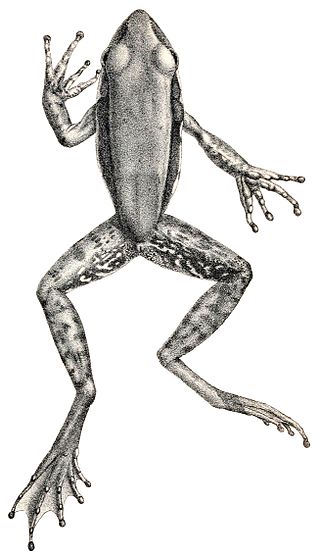
Papurana daemeli is a species of "true frog", family Ranidae. It is found in New Guinea, northern Australia, and some smaller islands. It is the only ranid frog found in Australia. In Australia, the species is restricted to the rainforest of northern Queensland and the eastern border of Arnhem Land, in the Northern Territory. In Australia, it is usually known as wood frog or sometimes as water frog. Other vernacular names are Australian wood frog, Australian bullfrog, and Arnhem rana.

Anomaloglossus parkerae is a species of frog in the family Aromobatidae. As currently known, it is endemic to Venezuela and is only known from near its type locality in the La Escalera, the Bolívar state, Venezuela, near the Guyanese border. However, its range is expected to extend southward to the Gran Sabana as well as into the adjacent Guyana. The specific name parkerae honors Dr. Nancy Parker, undergraduate adviser of one of the scientists who described the species.
Phrynobatrachus inexpectatus is a species of frog in the family Phrynobatrachidae. It is endemic to southern Ethiopia. It is known with confidence from only three localities, but it may be more widely distributed in the Ethiopian Highlands. The specific name inexpectatus refers to the unexpected discovery of this species among museum specimens assigned to Phrynobatrachus minutus. Common names unexpected puddle frog and Largen's dwarf puddle frog have been coined for it.

Phrynobatrachus minutus is a species of frog in the family Phrynobatrachidae. It is endemic to Ethiopia and occurs in the central and southern parts of the country on both sides of the Rift Valley; its range may extend south to Kenya, perhaps further. Some earlier records from Ethiopia represent Phrynobatrachus inexpectatus, described as a new species in 2001. The specific name minutus refers to the small size of this frog. Common names tiny river frog and Ethiopian dwarf puddle frog have been coined for it.
Cornufer punctatus, commonly known as the dotted wrinkled ground frog, is a species of frog in the family Ceratobatrachidae. It is endemic to Western New Guinea (Indonesia) and occurs in the Arfak and Wondiwoi Mountains in the Guinean mainland well as on some adjacent islands.

The Amami tip-nosed frog is a species of frog in the family Ranidae. It is endemic to the Amami Islands, a part of the Ryukyu Islands, Japan. Specifically, it is known from the islands of Amamioshima and Tokunoshima.
Papurana garritor is a species of frog in the family Ranidae. It is endemic to New Guinea and widely distributed, found in both Indonesian and Papua New Guinean parts of the island. Common name Eilogo Estate frog has been coined for it.
Odorrana junlianensis, also known as the Junlian odorous frog, is a species of frogs in the family Ranidae. It is found in southern China and in the northernmost Laos and Vietnam. Its type locality is the eponymous Junlian County in Sichuan.
Odorrana supranarina is a species of frog in the family Ranidae. It is endemic to Ryukyu Archipelago, Japan, and is known from the islands of Ishigaki and Iriomote, both in the Yaeyama Group. The specific name supranarina refers to the large size of this species —at the time of the species description, it was the largest member of the so-called Rana narina complex. Common name greater tip-nosed frog has been coined for it.

Taruga fastigo is a species of frogs in the family Rhacophoridae. It is endemic to Sri Lanka and only known from its type locality, Morningside Estate near Rakwana. Prior to its description in 2001, it was confused with Polypedates eques.
Papurana arfaki is a species of true frog, family Ranidae. It is widely distributed in New Guinea and also found on the Aru Islands (Indonesia). Common names Arfak Mountains frog and large river-frog have been coined for it. Its type locality is the Arfak Mountains.
Papurana attigua is a species of frog in the family Ranidae, the "true frogs". It is found in central and south Vietnam, eastern Cambodia, and southern Laos. The specific name attigua is derived from Latin attiguus meaning "neighbor". It refers to the similarity of this species to Indosylvirana milleti. The common name similar frog has been coined for this species.
Papurana grisea is a species of true frog. It is known with certainty only from its type locality in the Went Mountains, in the Indonesian province of Papua, New Guinea. Similar frogs are widespread in New Guinea, usually above 1,200 m (3,900 ft) above sea level, as well as on the Seram Island, but their identity is uncertain; they possibly represent another, undescribed species. Common names Went Mountains frog and Montaen swamp frog have been coined for it.

Papurana kreffti is a species of true frog, family Ranidae. It is native to New Ireland and Buka Island and the Solomon Islands. The specific name kreffti honours Gerard Krefft, a German adventurer who settled in Australia and became there to be regarded as the father of Australian herpetology. Common names San Cristoval frog and San Cristobal treefrog have been coined for it.
Papurana milneana is a species of "true frog", family Ranidae. It is endemic to Papua New Guinea where it is found in the upland areas of Milne Bay, Morobe, Northern, and Central Provinces, as well from the D'Entrecasteaux Islands and, tentatively, Louisiade Archipelago. It was originally described as a subspecies of Rana grisea, but raised to full-species status in 2007.

Papurana papua is a species of true frog, family Ranidae. It is endemic to New Guinea and found in the northern part of the island in both Indonesia and Papua New Guinea as well in some offshore islands. Common name Papua frog has been coined for it.
Papurana supragrisea is a species of true frog, family Ranidae. It is endemic to New Guinea, including some nearby islands. It is known with certainty only from southeastern New Guinea and from the D'Entrecasteaux Islands. However, this name has been used more broadly for a species complex that is widely distributed in the mountains of New Guinea. Common name Papua gray frog has been coined for it.
Papurana volkerjane is a species of true frogs, family Ranidae. It is endemic to New Guinea and is known from its type locality, the eastern slopes of the Wondiwoi Mountains, from the Fakfak Mountains, and from the Bewani and Torricelli Mountainss in the West Sepik Province, Papua New Guinea. Rainer Günther named the species after his son Volker and daughter-in-law Jane.

Papurana waliesa is a species of "true frogs", family Ranidae. It is endemic to Papua New Guinea where it is found in the southern Owen Stanley Range and the Pini Range in the eastern New Guinea as well as in the D'Entrecasteaux Islands. The specific name waliesa is derived from the Dobu word waliesa that means "namesake", in honor of Fred Malesa from Fergusson Island. He had greatly assisted the describers of this species during their expedition in the Milne Bay Province.
Meristogenys maryatiae, also known as Maryati's torrent frog, is a species of frog in the family Ranidae. It is endemic to the state of Sabah, in the Malaysian part of Borneo. The specific name honours Prof. Datin Mohamed Maryati, entomologist from the Universiti Malaysia Sabah, who helped the describers of this species during their herpetological surveys in Sabah.








